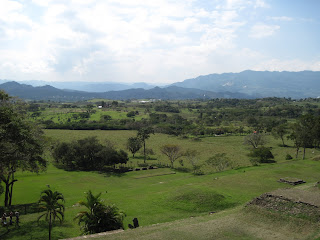I am back home now and spin-drying the full color memories of my trip to Chiapas. These are guaranteed to be color-fast, not to fade easily.
We were on the go each of our twelve days, either on our own, roaming the streets of San Cristobal de las Casas, or with our guide, Alex(www.cieloytierratours.com), exploring the ruins,
or the villages, or popular “water” spots: Sumidero Canyon, Agua Azul or El Chiflon.
Since Chiapas provides 35-50% (two different figures I heard…take your pick!) of Mexico’s hydroelectric power, you can imagine how much water there is in this southernmost state of Mexico. Supposedly the rainy season is from May through October, which adds up to big rivers, big waterfalls, BIG water. And with big water comes amazing GREEN, particularly in the lower elevations.
Since Chiapas provides 35-50% (two different figures I heard…take your pick!) of Mexico’s hydroelectric power, you can imagine how much water there is in this southernmost state of Mexico. Supposedly the rainy season is from May through October, which adds up to big rivers, big waterfalls, BIG water. And with big water comes amazing GREEN, particularly in the lower elevations.
Most amazing were our visits to the indigenous communities. With Alex we felt comfortable, rather than intrusive gringas. Under his direction, we put our cameras away, and tried to respect these villagers' requests to not be "in their faces” with our pushy western ways. San Juan de Chamula was the most unique village and certainly the strongest in their desire to retain their culture.
They have created their own religion (within the structure of the Catholic Church) and use this building as a gathering place for worshipping in their own way. The priests have been kicked out (except for baptisms) and it is common to see healers of all types at work, along with hundreds of candles burning (different colors for different requests),
 pox and coca-cola being consumed (burping up coke is a way to rid oneself of the bad), groups or individuals chatting, all dressed in indigenous clothing that is the norm. As I said before, it was like stepping back in time.
pox and coca-cola being consumed (burping up coke is a way to rid oneself of the bad), groups or individuals chatting, all dressed in indigenous clothing that is the norm. As I said before, it was like stepping back in time.
They have created their own religion (within the structure of the Catholic Church) and use this building as a gathering place for worshipping in their own way. The priests have been kicked out (except for baptisms) and it is common to see healers of all types at work, along with hundreds of candles burning (different colors for different requests),

 pox and coca-cola being consumed (burping up coke is a way to rid oneself of the bad), groups or individuals chatting, all dressed in indigenous clothing that is the norm. As I said before, it was like stepping back in time.
pox and coca-cola being consumed (burping up coke is a way to rid oneself of the bad), groups or individuals chatting, all dressed in indigenous clothing that is the norm. As I said before, it was like stepping back in time.All throughout these Mayan lands (from the Yucatan down to Honduras) there are many ruins of ancient sites. On this trip we visited three: Palenque, Tonina, and Tenam Puente.
To imagine what these sites must have been like 12 or 13 hundred years ago, with their incredible architecture and connection to the planets and the stars, seasons and their mathematical mastery is truly mind-boggling.
Another interesting aspect of this area was the recent revolution of the Zapatistas against the government. We saw two good movies on these revolutionary events that began in 1994, and although there is little that we witnessed on our trip besides signage along the roadsides and souvenirs in the shops, I believe it’s not over yet. The government has been more responsive to the Chiapanecans, but there’s a long way to go for the indigenous people to have their basic needs met.
The government has been more responsive to the Chiapanecans, but there’s a long way to go for the indigenous people to have their basic needs met.
Our travels in Chiapas once again confirmed that we are living in a truly amazing country with gracious people, fascinating history, and interesting culture. We never felt unsafe, as the northern media would like travelers to question. Go, visit, travel, search and find. All of Mexico is a jewel, waiting to be discovered.To imagine what these sites must have been like 12 or 13 hundred years ago, with their incredible architecture and connection to the planets and the stars, seasons and their mathematical mastery is truly mind-boggling.
Another interesting aspect of this area was the recent revolution of the Zapatistas against the government. We saw two good movies on these revolutionary events that began in 1994, and although there is little that we witnessed on our trip besides signage along the roadsides and souvenirs in the shops, I believe it’s not over yet.
 The government has been more responsive to the Chiapanecans, but there’s a long way to go for the indigenous people to have their basic needs met.
The government has been more responsive to the Chiapanecans, but there’s a long way to go for the indigenous people to have their basic needs met. 










2 comments:
Interesting Mary.
Kicking the Priest out had to be a smart move and the belching of Coca cola getting rid of the 'bad' has to be better than confessional, often used to spy on people. What makes you think it isn't over? Not that I'm surprised. Sounds like that tour guide is a great connection into the area. Will you go back in the future? Like your perspective.
Fantastic write up, Mary! It was a marvelous, colourful, informative and entertaining tour and you captured exceptionally well. Thanks!
Post a Comment